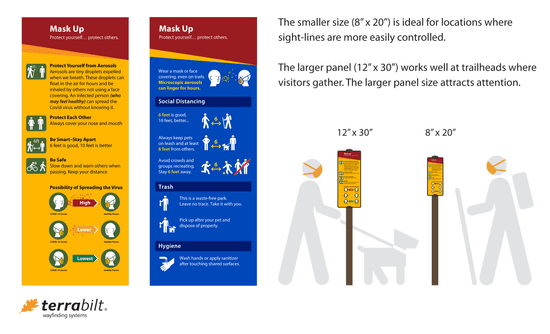




Don Meeker, president of Terrabilt, reflects on trails as a critical sanctuary during COVID-19, and provides guidance on signage to keep everyone on trails safe. Terrabilt will also provide the production artwork for their COVID-19 trail sign for free.
by Don Meeker, President, Terrabilt Wayfinding Solutions

In springtime 2020, hikers, riders and walkers came out of the house and headed for the trails. After months, the sequestered life was wearing thin; people wanted to fill their lungs with clean spring air. Parks were going to be a critical sanctuary through the pandemic.
I was part of that exodus off the front porch and was amazed by the number of people massing on the trail. Since face covering was recommended, I was surprised by the number of hikers without protection.
Hiking on a trail is a lot safer than going to choir practice in a stuffy church basement, but crowded trails are not without risk. On the busy popular trails this past spring, fast hikers passed slower hikers and returning hikers came in great numbers. In each case, the passing zone was – more likely than not – a close maneuver. Heavy breathing was part of the mix.
Soon there were plenty of signs for masking and social distancing (6 feet apart), while the specifics of protection were evolving.
What we read in the popular press confirmed that outside recreation was not without hazard. In early May the New York Times and the Wall Street Journal
chronicled what scientists were finding about the transmission of Covid-19. They recommended masking up and social distancing.
Joseph Allen, the Director of the Healthy Buildings program at Harvard T.H. Chan School of Public Health suggested that there was increasing evidence that Covid-19 can spread as small particles (5% of the width of a human hair) called aerosols, released through breathing, talking, singing and other activities. Unlike larger droplets, aerosols can linger in the air for hours.
I believed there needed to be a message particularly for trails. The signs should be prominently posted at trailheads; the message needed a clear focus and explain that asymptomatic individuals could transmit the virus.
As a designer of signage for parks, trails and preserves, I wondered how our team could best tell the aerosol story at the trailhead. The target audience would be the hiker with a pocketed mask. A good explanation of viral transmission should convince that hiker to use that mask.
We focused on the specific need to mask-up all the time. Our design used symbols and offered a succinct message with key words. In the language of the interpreters, we wanted to communicate with the streaker (who glances at signs), the stroller (who reads signs superficially) and the student (who reads signs carefully). A vertical (8” x 20” or 12” x 30) panels allowed for easy reading. We shared our design with clients and received their comments. (See attached yellow panel)
By September, we saw compliance with face covering improve as folks in the Northeast were taking precautions seriously. New research based on the first 9 months of the pandemic projected that universal mask use (95%) could reduce mortality by nearly half. As for complaints about wearing masks, an Israeli study at the Rambam Health Care Campus in Haifa compared oxygen levels, heart rates and other physiological measures during and after vigorous exercise by serious runners and cyclists with and without masks and found no difference.
In a second-generation design, we concentrated on the most essential items. Our Covid-19 message was to wear a mask and keep physical distance. We integrated that information with routine trail etiquette (health and hygiene). (Attached blue panel illustrates)
The development and approval of the vaccines for Covid-19 is great news, but face coverings are not going away for at least 10 to 12 months. A serious message deserves a quality presentation. We recommend that these postings be mounted prominently.
If you wish to receive a free copy of production artwork of our designs, email your request with contact information and affiliation to: [email protected].
Please see the PDF below of the artwork for the COVID-19 signs.
For further reading:
From The New York Times: What You Can Do Post-Vaccine, and When
Particularly in the early months of vaccination, many activities should wait, experts say — and plan to keep your masks.
Download the Terrabilt Graphic
iZone Imaging Brings Bugtopia to Life Through Signage
posted Jan 14, 2022
iZone Imaging’s High Pressure Laminate brings to life the interpretive signage throughout the Brawn Family Foundation Bugtopia Playground at the Calgary Zoo. The signs are eco-friendly and can withstand the high traffic interactive area over time. (Sponsored Content)
Signage Solutions for Every Trail System
posted Jun 11, 2021
Pannier is the leading manufacturer of signs, panels, exhibit bases, and frames. With a full line of exhibit bases, there is a product for every trail and wayside application.
posted May 7, 2021
This National Sign Guidebook presents information for planning, designing, fabricating, procuring, installing, and maintaining signs in a clear, complete, and user friendly format.
posted May 6, 2021
The purpose of this document is to provide the required tools for trail planners, designers, and contractors to deploy a cohesive trail signage program throughout the City of San José’s Trail Network.
2,630 views • posted 01/08/2021